| 319
|
CHAPTER 49
Playmates as Therapists:
Helping Fernando Learn New Skills

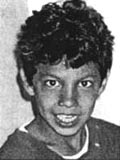
In Chapter 45, we saw how Child-to-Child
activities helped Jesús' classmates and teacher to better understand his
needs and possibilities. Here, we see how the playmates of another
disabled child succeed in helping him to learn useful skills and
activities that adults had been unable to teach him.
FERNANDO is slow to trust adults. He has good
reasons. Since he was a baby, he has been hurt in different ways by
grown-ups who wanted, in their own way, to help him.
Fernando's mother grew up in a small village, but in her early
teens she went to the city to study. There she was courted by a young man,
whom she soon married. Months later, a baby was born and they named him
Fernando. He was a lovely child with golden curls. At first, the signs of
his cerebral palsy were not very obvious.
After three difficult years, the marriage broke up. Both parents
fought to keep the child. One night, Fernando's father came home to the
village, very drunk. He kidnapped the little boy from the mother's family
at gunpoint. But as the child grew, spasticity and other signs of cerebral
palsy became clearer. He began walking at the age of 4, with a spastic,
knock-kneed gait. He has never been able to talk. Unwilling to accept that
his son was disabled, his father took him to one doctor after another,
seeking a cure. Some doctors said the boy's condition was hopeless:
nothing could be done. Others performed costly tests and prescribed costly
medicines. Unwilling to raise a son whom he considered "minusvalido" (less
valid), his father took Fernando back to his mother.
But by this time, the boy's mother had another lover who, like his
father, did not want an "invalid." In the end - as often happens -
Fernando's grandmother took the child in. She loved him and wanted the
best for him. But her own husband had died (of tuberculosis and
alcoholism), and she had trouble maintaining her small store to make ends
meet.
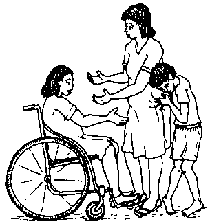
Fernando's grandmother lives in Ajoya, where PROJIMO is located. The
PROJIMO team offered her advice and, when Fernando was 5, encouraged her
to put him in kindergarten. Year after year, he attended school, but he
never got beyond the first grade. The boy was alert and in some ways
seemed intelligent. But he had a learning-disability with talking and
reading. After repeating first grade for 5 years he still could not write
his name.
Rather than focusing on the "3 Rs," the PROJIMO team thought it might
be more enjoyable and useful for Fernando to learn some practical skills.
They made repeated efforts to include the boy in activities at PROJIMO: in
the Playground for All Children, and the Children's
Toy-Making Workshop. But even at age 11, the boy was still very
timid, especially around adults.
One day when a physical therapist was visiting PROJIMO, Fernando's
grandmother took him there for another evaluation. Terrified, the boy
clung to Grandma's dress, his head down. Trying to win his confidence,
Mari asked him if he would like to play on the swings or the
merry-go-round. Fernando shook his head "NO!" and burst into tears at the
thought of it. He was still very fearful of adults. |
| 320
|
Playmates as Therapy Helpers

The PROJIMO team thought that Fernando's manner of walking might be
improved with gait and balance activities. But despite their best
efforts, Fernando refused to cooperate.
One day, Mari, who has helped to facilitate Child-to-Child activities
with school-aged children, had an idea. "Fernando is so fearful with us
adults," she observed, "even when we try our hardest to befriend him.
Yet, outside his house, I often see him playing with other little boys
with whom he is wild and fearless. Why don't we invite his young friends
to come to PROJIMO, and bring Fernando with them? We can explain some
play activities to his friends that could help Fernando improve his
walking and balance. Maybe they can also get him involved in the
toy-making shop, where they can all learn to make and paint toys
together. That way Fernando could start learning useful skills."
Everyone thought this was a splendid idea. Conchita talked to
Fernando's young friends, and to their mothers. Fernando's playmates
were excited with the idea and wanted to help.
The Board-Walk Balance Game

The next day the two young boys, Manuel y Chito, arrived at PROJIMO,
followed - somewhat nervously ~ by Fernando, who lurched awkwardly from
side to side as he tried to keep up. Mari suggested a game to help
Fernando improve his foot-control and balance. Directing from her
wheelchair, she asked the children to bring several boards down from the
loft, and to place them over bricks to form narrow walkways.
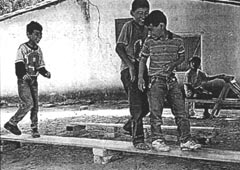
Fernando, following the example of his friends, helped to carry the
bricks and place them on the ground to support the boards. This was not
easy for him. But somehow he managed to bend down, pick up the bricks
with his spastic hands, carry them with his scissored gait, and place
them under the giant fig tree. This way, not only the
play-therapy activities, but also his involvement with his playmates in
preparing the equipment, helped Fernando to develop body control.
When the "boardwalk" was in place, Mari asked the children to
"follow the leader," walking back and forth on the boards. The
10-inch-wide boards were about 6 inches above the ground. The two
able-bodied boys bravely "walked the plank," and Fernando fearlessly
followed. He tipped precariously this way and that, looking as if he
would surely fall off. But, to everyone's amazement, he kept his
balance, grinning happily as he followed his friends back and forth.
Everyone applauded. |
| 321
|
| Mari knew it was a good idea to have
started Fernando with an activity he could succeed at easily. It gave
him confidence. But this was too easy. He needed more of a challenge. So
Mari had the boys arrange 3 long boards, each only 2 inches wide, in a
triangular path.

Mari challenged the boys to walk as many rounds on the boards as they
could without falling off. Fernando, despite his wobbling back and
forth, waving his arms wildly to keep his balance, did amazingly well.
At first, he - and occasionally also one of the other boys - sometimes
lost their balance. But he rapidly improved until he rarely lost his
footing on the narrow board.
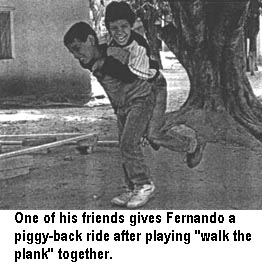
Mari laughed at herself. "I thought Fernando needed to improve his
balance!" she declared. "But he has incredibly good balance - better
than I had before my accident!" She realized that he needed - and had
developed - exceptionally good balance to be able to walk and run with
legs that only imperfectly followed his wishes.
Important as these activities were for Fernando's balance and
positioning of his feet, they were equally important for his growing
sense of confidence among a mixed group of children and adults.
He very quickly appeared to be a very different child than the one
who had arrived a few days before and had hung miserably to his
grandmother's dress.
Spontaneous play and interaction with other children had as much
therapeutic value, both physical and social, as did the specially
designed activities. |
| 322
|
Introduction to the Toy-Making Workshop
After their play on the "board-walk," the three boys were eager to do
something different. Mari led the way to the toy-making workshop. This
small shop was set up to involve disabled and non-disabled children
together in making early-stimulation toys and puzzles, especially for
children with developmental delay. (See pages
290-291.)
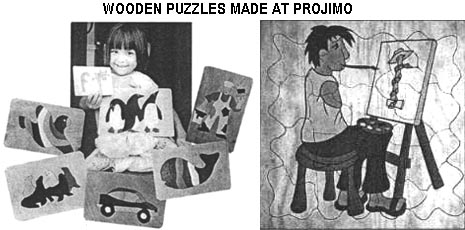
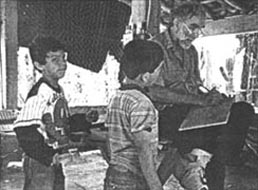
To interest the 3 boys in making toys, Mari asked the help of
Manuella, a village girl who works in the toy shop. Manuella agreed
to cut out wooden figures of animals or persons for each of the 3
boys, which they could sand and paint. The boys asked her to cut out
figures of themselves. David (the author of this book) drew the
boys, each posed in the position he wanted to appear in. |

Then the boys watched, fascinated, as Manuella cut out the
figures on the electric jig saw. The figures emerged: Chito in a
Karate pose, Manuel as a muscle man, and Fernando dancing. |
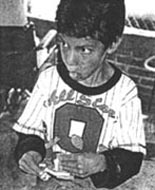
The boys carefully sanded the wood figures. With his spastic
hands, Fernando had difficulty holding the figure and trying to sand
it. But the other boys showed him how. Fernando did his very best. |
|
| 323
|
|
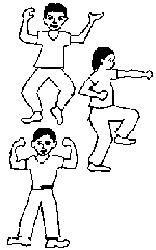
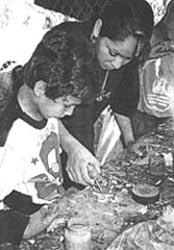
Next the boys painted the wooden figures of themselves. At first,
Fernando had trouble holding and controlling the brush, and Manuella
helped him by guiding his hand.
At last the boys finished painting the figures of themselves, and
held them up with delight.
Although Manuel and Chito greatly enjoyed the activities themselves,
they also took their job of helping Fernando to learn new skills quite
seriously, and they felt proud when they saw him manage to do new
things.
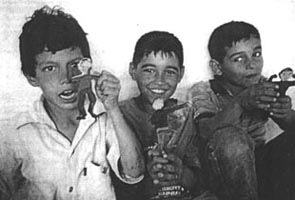
|
| 324
|
| Making other toys. The
children wanted to make other toys in the workshop. They asked Fernando
if he wanted to make an animal, and began to name different kinds: A
chicken? A dog? A cow? A cat? A raccoon? Fernando shook his head "No!"
at each suggestion. Then the boys said "A Horse?" Fernando grinned and
nodded. Chito and Manuel said that they, too, wanted to make horses.
Excited, Fernando had yet another idea, but unable to speak, he had
trouble communicating it. Everyone asked him questions about other
animals or figures he might want to make. He kept shaking his head.
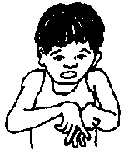
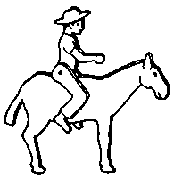
At last, Fernando made a gesture, as best he could with his spastic
hands. It was something like this.(Left)
"He wants a rider on his horse!" cried Manuel.
"Then a horse and rider you will have!" said Manuella. She created a
simple design. The rider was made of 3 pieces of wood: the body and two
legs. The movable legs were attached to the hips with a small nail, so
that the rider could be seated firmly on the horse.
Of course, all of the boys wanted a horse and rider. Again, they
sanded and painted them lovingly. This time, one of the boys held the
pieces while Fernando carefully painted them. He now seemed to have more
hand control, which perhaps came partly from greater confidence.
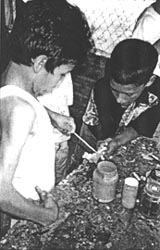
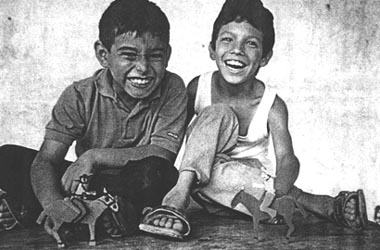
This Chapter continues to the NEXT
page |
|